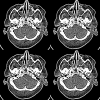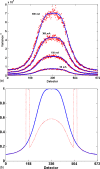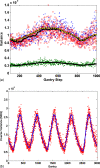Validation of CT dose-reduction simulation
- PMID: 19235386
- PMCID: PMC2673664
- DOI: 10.1118/1.3031114
Validation of CT dose-reduction simulation
Abstract
The objective of this research was to develop and validate a custom computed tomography dose-reduction simulation technique for producing images that have an appearance consistent with the same scan performed at a lower mAs (with fixed kVp, rotation time, and collimation). Synthetic noise is added to projection (sinogram) data, incorporating a stochastic noise model that includes energy-integrating detectors, tube-current modulation, bowtie beam filtering, and electronic system noise. Experimental methods were developed to determine the parameters required for each component of the noise model. As a validation, the outputs of the simulations were compared to measurements with cadavers in the image domain and with phantoms in both the sinogram and image domain, using an unbiased root-mean-square relative error metric to quantify agreement in noise processes. Four-alternative forced-choice (4AFC) observer studies were conducted to confirm the realistic appearance of simulated noise, and the effects of various system model components on visual noise were studied. The "just noticeable difference (JND)" in noise levels was analyzed to determine the sensitivity of observers to changes in noise level. Individual detector measurements were shown to be normally distributed (p > 0.54), justifying the use of a Gaussian random noise generator for simulations. Phantom tests showed the ability to match original and simulated noise variance in the sinogram domain to within 5.6% +/- 1.6% (standard deviation), which was then propagated into the image domain with errors less than 4.1% +/- 1.6%. Cadaver measurements indicated that image noise was matched to within 2.6% +/- 2.0%. More importantly, the 4AFC observer studies indicated that the simulated images were realistic, i.e., no detectable difference between simulated and original images (p = 0.86) was observed. JND studies indicated that observers' sensitivity to change in noise levels corresponded to a 25% difference in dose, which is far larger than the noise accuracy achieved by simulation. In summary, the dose-reduction simulation tool demonstrated excellent accuracy in providing realistic images. The methodology promises to be a useful tool for researchers and radiologists to explore dose reduction protocols in an effort to produce diagnostic images with radiation dose "as low as reasonably achievable".
Figures












References
-
- Kalender W. A., Computed Tomography: Fundamentals, System Technology, Image Quality, Applications, 2nd ed. (Publicis MCD Verlag, Munich, Germany, 2005).
-
- Brenner D. J. and Hall E. J., “Computed tomography—An increasing source of radiation exposure,” N. Engl. J. Med. NEJMAG 357(22), 2277–2284 (2007). - PubMed
-
- Frush D. P., Donnelly L. F., and Rosen N. S., “Computed tomography and radiation risks: what pediatric health care providers should know,” Pediatrics PEDIAU 112(4), 951–957 (2003). - PubMed
-
- Russell T. D. and Van Metter R. L., “Computer simulations demonstrating factors that influence the quality of radiographic images,” Radiology RADLAX 173, 471 (1989).
Publication types
MeSH terms
Grants and funding
LinkOut - more resources
Full Text Sources
Other Literature Sources
Medical
Research Materials

